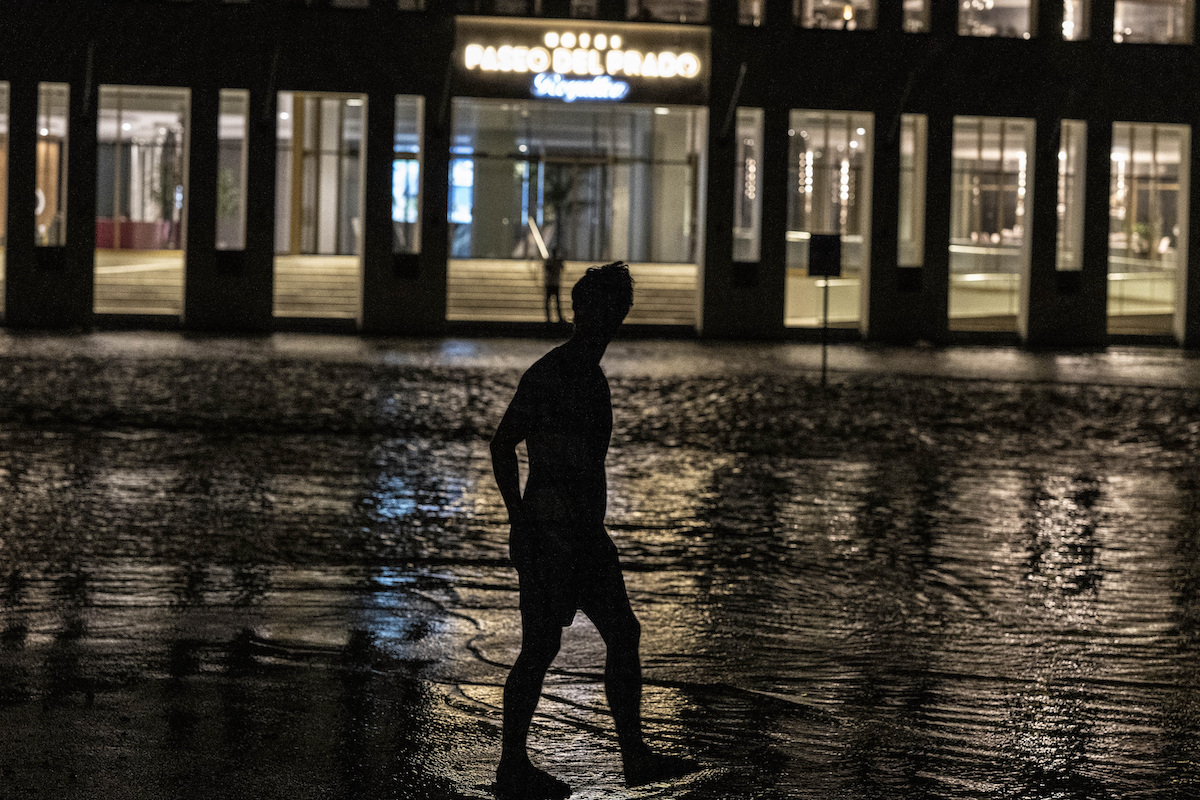

A man walks through a flooded street in front of a hotel powered by an oil generator during a blackout in Havana, Cuba, Wednesday, Sept. 28, 2022. Cuba remained in the dark early Wednesday after Hurricane Ian knocked out its power grid and devastated some of the country’s most important tobacco farms when it hit the island’s western tip as a major storm. (AP Photo/Ramon Espinosa)
On Tuesday, September 27, Hurricane Ian, a Category 3 storm, swept over the western region of Cuba, devastating the province of Pinar del Río and bringing severe effects to the capital city of Havana.
In addition to the various breakdowns caused by the storm, on Wednesday afternoon, the island suffered a total collapse of its national electrical system. For several hours that night, the island remained offline, evincing the decades-long lack of maintenance and investment, and of Cuba’s failed energy policies—all expressions of the administrative incapacity of a government not subject to scrutiny or change.
In response, a series of protests have broken out in the country beginning on Thursday. Fragmented demonstrations were held in traditionally poor and marginalized neighborhoods, where lack of electricity affected the supply of water, gas, and, above all, the conservation of food.
With a structural economic crisis that has already lasted decades, exacerbated by the effects of the COVID pandemic and the impact of U.S. sanctions, accessing food and medicine in Cuba is agonizing. Protesters’ demands for electricity, water, and food were soon joined by markedly political demands, which have been summed up in a cry for freedom.
Proyecto Inventario has so far counted more than 50 protests in the last four days, located in 26 places across the country’s capital. They are neighborhood protests, peaceful, with various demands, and organized through informal networks of neighborhood solidarity, not articulated among themselves. Notably, many of the participants are women, young people, and children.
Cacerolazos (pot-banging protests) have broken out with intensity. Streets have been closed and barricades built to draw the attention of authorities. Learning from the repression that followed the protests in July of last year, few demonstrators now risk exposing their faces for identity. Now, instead, backs are filmed, names are avoided, and information is shared on personal profiles on social media.
Repression, ever-present, has shifted to less explicit forms. During the first and second nights of protests, the regime completely cut off internet service on the island. Even the pages of official newspapers or government sites were offline—a clear attempt to mitigate the impact of real-time images and avoid a domino effect like the one seen during last year’s protests.
The authorities have publically accepted the fact that protests for basic services are legitimate, though they insist that such demonstrations should only happen when governments do not do their job. Government spokesmen appear on TV programs to display an understanding of the social unrest.
On the other hand, the Cuban regime insists once again on transferring the national crisis to geopolitics, denouncing the media war and the responsibility of Cuban exiles abroad and the U.S. government—thus dismissing the legitimacy of the protests. Night brings soldiers dressed in civilian clothes and armed with sticks, along with extensive police deployment in the areas of greatest conflict.
The documentation and denunciation of human rights violations have been met with intimidation. The lack of internet access and power has prevented the recording and transmission of images and videos. It’s difficult to disseminate such images due to their quality, the anonymity of the people who record them and their testimonies, and the current caution of media in light of the rise of fake news. However, so far we know of at least a dozen arrests and multiple beatings of young people. As the electricity is restored and the internet connection stabilizes in the following days, we will probably learn more.
The protests come after a year of repression and trials that punished the July 11 demonstrators with up to 30 years in prison. More than a thousand remain in prison since then. They face the threat of a new penal code that criminalizes activism and inhibits citizen action and social articulation.
Despite this, the current protest seems to be here to stay. From precariousness and fear, Cubans are building citizenship.
***
Johanna Cilano Pelaez is a lawyer and political scientist. She is a member of Red De Politólogas, which highlights women working in Latin American political science, and is a founder of Gobierno y Análisis Político AC, which specializes in analysis, political advisory, and citizenship training and advocacy. Twitter: @CilanoJohanna



[…] post Protests and Crackdown in Cuba After Hurricane Ian (OPINION) appeared first on Latino […]
[…] Source link […]